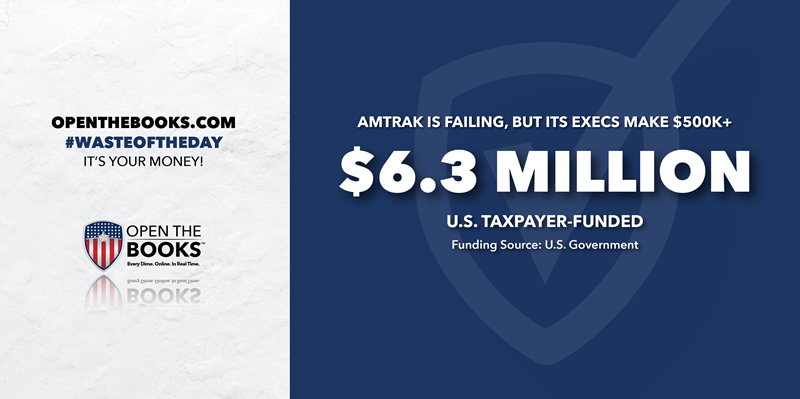
Federal Agencies Spent $3.3 Billion on Office Furniture While Employees Worked from Home
October 16, 2023

Despite the vast majority of federal government employees working from home during the pandemic years of 2020, 2021 and 2022, federal agencies purchased $3.3 billion in new furniture, OpenTheBooks.com auditors found.
Most major federal agency headquarters were one-quarter full or less, and none were at 50% capacity or more, according to a report from the Government Accountability Office.
The U.S. Departments of Transportation, Agriculture and the General Services Administration each used only 9% of their office space.
The DOT spent $55 million on furniture, Agriculture spent $57 million, while GSA spent a whopping $308 million on furniture, OpenTheBooks.com found.
Department of Veterans Affairs used just 16% of its office space and spent $428 million on furniture, while the Department of Justice used just 35% of its office space yet spent $408 million on furniture.
Department of Defense utilized just 23% of office space and spent a massive $1.2 billion on furniture — the biggest furniture spender over five years, totaling $2.1 billion in 2018-2022.
The State Department spent $302 million and Homeland Security spent another $156 million on furniture.
“As Congress continues to fight over spending, we want to make it clear that there are massive amounts of money being appropriated, spent, wasted and sometimes hidden from the taxpayer,” OpenTheBooks.com Founder & CEO Adam Andrzejewski said.
“In the case of office furniture, most federal headquarters are barely a quarter full on a given workday, and no major agency is at more than half capacity. Yet for some reason we’ve bankrolled another billion dollars in desks, chairs, couches and more – while employees clock in from their own living rooms.”
Top 10 Amtrak Execs Make $500K Each, Despite Record of Losses and Poor Service
October 17, 2023

The top ten executives at Amtrak each make between $504,000 and $780,000 per year, despite a long record of delayed and disrupted service, enormous federal funding and billions in Covid aid, OpenTheBooks.com auditors found.
Amtrak provided the pay of its top executives totaling $6.3 million, but denied OpenTheBooks.com’s Freedom of Information Act request for the payroll of its 19,000 employees, citing FOIA Exemption 6 , which permits the government to withhold information citing an unwarranted invasion of personal privacy.
But our auditors calculated that those employees make an average of $121,000 – a hefty six-figure paycheck.
The national train service received $6.6 billion from the Federal Railroad Administration last year and another $6.8 billion this fiscal year.
Those figures are exclusive of a $1 billion payment from the CARES Act in 2020 (when ridership was down 90%), and another $1.7 billion from the American Rescue Plan Act of 2021. In just two years, that’s a total of $16 billion of taxpayer funding.
The results? From signal problems in Chicago and nationwide server issues, to wire issues in New Jersey, slowing and stopping trains, and expected service disruptions in the Adirondack line that runs between New York City and Hudson Valley into Montreal, the trains are often delayed. According to The Washington Post, the problems are unlikely to dissipate in the immediate future.
Amtrak’s trains are also taking losses.
The high-speed Acela running from Washington, D.C. to Boston, has long been a revenue driver for Amtrak, making $95 per mile traveled.
Now it loses $2 per mile.
In a June hearing before the U.S. House Committee on Transportation and Infrastructure, Railroads, Pipelines, and Hazardous Materials Subcommittee Chairman Troy Nehls (R-TX) noted that since its 1971 creation, Amtrak has never made a profit.
Despite The Infrastructure Investment and Jobs Act, which gave historic funding to railroads, with a large portion of that money going to Amtrak, “Amtrak predicts it will lose roughly $1 billion per year, with those losses largely covered by the taxpayers,” Nehls said.
“In the private sector, accountability would come in the form of an ‘Out of Business’ sign,” OpenTheBooks.com Founder & CEO Adam Andrzejewski said. “In the pseudo governmental realm, taxpayers should at minimum be allowed to scrutinize the pay and performance of the 19,000 employees that keep Amtrak barely chugging along. Instead, the feds choose to use a technicality in the law to shield Amtrak from proper accountability, a practice that’s all too common in the Beltway.”
GOP Lawmakers Lead Congress’ $13 Billion Earmarks in FY2024
October 18, 2023

Of the 10 U.S. senators who commanded the most pork barrel spending in earmarks for next fiscal year, eight are Republicans, most of whom sit on powerful Appropriations Committee
OpenTheBooks.com auditors analyzed the full list of over $5.4 billion worth of earmarks approved for 2024 federal spending bills on the Senate side of the Capitol, under Appropriations Committee Chair Rep. Patty Murray (D-Wash.).
Only one Democrat, West Virginia’s Sen. Joe Manchin, and one Independent, Maine’s Angus King, made the ignominious top ten. Added together with $8.2 billion in House earmarks, it’s a $13 billion fleecing of the federal taxpayer.
The senator who managed to capture the most pork barrel spending was Sen. Susan Collins (R-Maine), who earmarked $556 million. The total Senate haul for Maine, when counting individual earmarks and those co-authored with King, comes to $568 million.
The average senator is taking home $120 million in earmarks, less than a quarter of Collins and King’s tally. Yet Maine is the 42nd largest state by population, with under 1.4 million people — about the same population as San Diego.
In the House of Representatives, similarly, Republicans lead the $8.2 billion in earmarks as the top 63 spenders. The first Democrats makes the list in 64th place for total federal tax dollars captured.
Reps. Chellie Pingree and Jared Golden, both Democrats, also secured another almost $27 million through 30 earmarks for Maine, paying for school and youth programming, public safety, water treatment, housing projects, road and infrastructure improvements, among other things. "When Republicans supported the return of earmarks in late 2022, it was the equivalent of providing open bar to alcoholics,” OpenTheBooks.com Founder & CEO Adam Andrzejewski said. “Both parties are addicted to spending taxpayer money.”
"The national debt is our #1 national security threat and every dime of earmark, pork barrel spending is borrowed. That's immoral."
Throwback Thursday: Dept. of Education Outlays Increased $2 Billion in One Year
October 19, 2023

Throwback Thursday!
In 1980, the Department of Education’s staffing headcount ballooned, and outlays increased by $2 billion – worth $7.5 billion in 2023 dollars – after promising just years before it wouldn’t need any more staff or money.
Sen. William Proxmire, a Democrat from Wisconsin, awarded the Department of Education his Golden Fleece Award for this bureaucratic gluttony.
According to Proxmire, the Department of Education promised that no more staff or additional funds would be necessary in the immediate future. Just a year after its creation in 1979, however, it became clear that the Department of Education was not entirely forthcoming in this assessment.
From 1979 to 1980, the Department's staff increased by 157 people, in addition to the 1,121 personnel it had added the year before. Its budget authority, or the total amount it was authorized to be allocated, increased $1 billion, while its outlays for its programs, or the amount it was sent by the federal government, increased by $2 billion.
This was after countless reports and claims by members of Congress and executive officials that assured Congress the new Department of Education would require no additional people and no new funds.
The department blamed the increased headcount on Congress, who the department claimed insisted on additional employees for its Office of Civil Rights, but Proxmire found the administration had initially made the request for more workers, not Congress.
As for funds, Proxmire found personnel compensation rose 44%, contractual services rose 51%, and capital assets rose 47% over just one year.
The story of the inception of the Department of Education is a cautionary tale in the tendency of bureaucracy to expand, even when it initially has no intention of doing so, and why lawmakers should be skeptical of any new programs or proposals that claim not to need more people or money.
Labor Dept. Gives Early Dismissal for Indigenous Peoples’ Day, Costs $2.3 Million
October 20, 2023

In yet another example of what we've dubbed “Club Fed” because of generous vacation, salary and other benefits in the agencies, the Department of Labor sent an email to employees outlining yet another perk of federal employment: three hours extra paid time off after early dismissal the Friday before ‘Indigenous Peoples’ Day.”
While employees are off for “Indigenous Peoples’ Day,” a holiday first recognized by President Joe Biden in 2021 the same day as Columbus Day, they were able to start the long weekend early the Friday before, according to an internal email that OpenTheBooks.com auditors reviewed.
It will mean another $2.3 million in tax dollars gone to paid time off piled atop an already-hefty list of observed holidays.
Acting Secretary of Labor Julie Su made the announcement in an email in which she laments “deplorable and harmful aspects of colonialism” related to the existence of the United States.
According to public disclosures, 14,712 Department of Labor employees had $1.6 billion in salaries for FY 2022, not including benefits (which typically amount to about 30% of salary) or bonuses.
That amounts to an average salary of $109,030 a year. Three additional hours of paid time off for the entire department staff amounts to $2.3 million of lost productivity or opportunity cost for U.S. taxpayers.
The perk extends to employees who telework, allowing them to log off three hours early.
The extra time is added to the 11 federal holidays that employees enjoy throughout the year, including eight hours for Columbus Day/Indigenous Peoples’ Day. On average, federal workers also receive 13 sick days and 20 vacation days per year. That's 44 days of paid time off each year.
“Federal employees already receive generous salaries and time off versus the private sector, all furnished by taxpayers,” OpenTheBooks.com Founder & CEO Adam Andrzejewski said. But the benefits of Club Fed seem to keep growing. This new holiday perk from the Department of Labor follows news that Homeland Security Secretary Alejandro Mayorkas has approved 115 additional hours of paid vacation time for his employees.”
The #WasteOfTheDay is presented by the forensic auditors at OpenTheBooks.com.